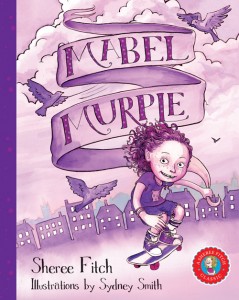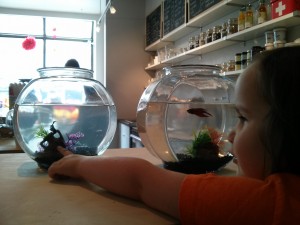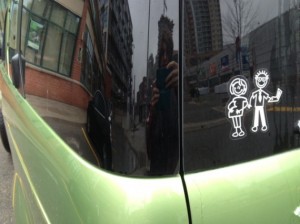February 18, 2014
The Not-So-Good Terrorist: Reading Zsuzsi Gartner’s “Better Living Through Plastic Explosives”
 This essay first appeared in No 83 (Winter 2011) of Canadian Notes & Queries, a publication for which it is a pleasure to be write.
This essay first appeared in No 83 (Winter 2011) of Canadian Notes & Queries, a publication for which it is a pleasure to be write.
Though Zsuzsi Gartner’s “Better Living Through Plastic Explosives” is set with home and hearth at its centre, the story offers glimpses outside into the dystopian Vancouver that is the backdrop to most of Gartner’s collection of the same name. Speeding cars burn rubber on streets whose sidewalks are littered with overturned shopping carts, as well as “used condoms, syringes, and the inevitable orphaned muffler”. For protection, Gartner’s protagonist, “the recovering terrorist”—who is also a gardener—has erected a botanical barricade around her house. And in the story’s opening paragraphs with their vivid imagery of the barricade, we receive our first reference to the maternal as an explosive, brutal force.
The force is the proverbial Mother Nature, of course, whose foliage clumps and billows. A magnolia with “vulvic flesh… erupts in the living room window.” Blood grass is described as “knifing the air, while underground its roots go berserk.” The recovering terrorist is Mother Nature’s agent, standing in the garden with a watering can full of fish fertilizer which she drops when another speeding car tears down her street, “a fifteen-year-old future ex-con at the wheel.”
The recovering terrorist is optimistically named, so-called for her membership in a support group whose membership includes, “Sterling, the tree-spiker…, Molly, who’d waged a campaign of terror against her West End neighbourhood’s johns.” She’d discovered the group by answering a newspaper ad, and now meets for support over Peak Freans and instant coffee. She has her sponsor on speed-dial, a former AIDS activist called Dieter who’d sworn off violence after a narrowly escaping harming an innocent child.
Our recovering terrorist, however, had not had the fortune of such an escape. Twenty years before, she’d set fire to a house “to bring a petty capitalist to his knees”, the owner of a company whose chlorine-filled diapers were exported to cause testicular cancer in third-world baby boys. The house was supposed to have been empty, but she got the dates wrong, and a child died, a friend of the family. The recovering terrorist was never caught, and paid no price for her crime, so has never been able to move past it.
 Her guilt, however, hasn’t quelled her impulses towards violence, though she has found ways to divert them. The recovering terrorist, brutal Mother Nature’s agent, hosts a “gardening bitch” radio call-in show, issuing advice like, “Gardening is like warfare, and it’s time for you to call in the troops”. She recommends diatomaceous earth to kill slugs, which is “like crawling through ground glass.” She says, “An eye for an eye, as they say, a tooth for a tooth.”
Her guilt, however, hasn’t quelled her impulses towards violence, though she has found ways to divert them. The recovering terrorist, brutal Mother Nature’s agent, hosts a “gardening bitch” radio call-in show, issuing advice like, “Gardening is like warfare, and it’s time for you to call in the troops”. She recommends diatomaceous earth to kill slugs, which is “like crawling through ground glass.” She says, “An eye for an eye, as they say, a tooth for a tooth.”
Gartner further subverts maternal stereotypes by representing the recovering terrorist’s extremist tendencies as inextricably linked to motherhood. In fact, her impulses have never been so strong: “For all her past-life bravado, she finally understands what it means to be willing to die for something, or rather, someone. [Her son] is her ur-text, her Gospels, her Koran.”
The recovering terrorist is called Lucy, though she goes unnamed throughout much of the story. This is partly a satire of the pseudo-anonymity of self-help groups, but also significant because Gartner makes naming an act of colonization, of possession, and in her guilt, the recovering terrorist no longer wants to possess herself. (And perhaps she just doesn’t like her name: “…a name that sounds like fresh fruit, an ingénue of a name. Girl terrorists all seem to have perky names—Squeaky, Patty, Julie—as if they can’t quite take themselves seriously enough.”)
That the recovering terrorist has named her son Foster indicates a suspicion that her possession of him might be temporary. Like all parents, she must strike a balance between keeping him safe and giving him freedom to explore the world, to pursue his passions, which (at the age of seven) include Pokémon, and mastering the unicycle. The former passion connects mother and son, as she is fascinated by the game’s playfully violent mythology, and the latter dividing them—his hobby has turned her into a foolish caricature of parenthood, standing anxiously on the sidewalk shouting, “Careful!”
Foster, when he was younger, “like all fledgling humans”, had what the recovering terrorist describes as a “hunger for naming”, and it was his mother’s job to feed it: “Manhole covers, squirrels, body parts, graffiti, discarded condoms, black-eyed susans, facial deformities of fellow passengers riding the No. 20 bus. That got name?” Now that he is older, Foster’s hunger is satisfied with his playing cards, characters with names like Vulpix., Lickitung, Dusknoir, and Slugma. And Gartner makes implicit a link between Foster’s hunger for names, and the recovering terrorist’s own urges to “inflict order” on her universe.
She is trying hard to stay recovering. When the dangerous outside world permeates her barricade via the speeding cars in the street—when they make her fear for her son’s safety and the sanctity of her home and neighbourhood—she tries to play by the rules. She solicits City Hall to install a “speed retardant”, and finds herself tangled in red tape idiocy. Gartner satirizes bureaucratic processes, and employs a most inspired literalized metaphor for the futility of fighting the system: the civil servant without a larynx, who holds his finger to his throat to emit robotic answers to the recovering terrorist’s concerns. “She is arguing with a guy who has no voice box.”
When playing by the rules gets her nowhere the recovering terrorist feels compelled to take matters into her own hands. She’s thinking of the children, of course; “For Lucy, it always comes down to the babies.” Just as 20 years ago she’d set a fire in the name of third-world baby boys, it is for the sake of her son on his unicycle that now she considers blowing up speeding cars along with their drivers. There’s nothing gentle about the recovering terrorist’s maternal touch, which is always further undermined by her collateral damage, the little girl she killed in order to protect other children: “It’s always the mother’s fault. As they say.”
 As her son had been troubled by unnameable things as a young child, so too does the recovering terrorist continue to be, for these unnameable things violate her need for order. Her love for her son, for example, which, she admits, “complicates things.” In fact, she’s not even sure if what she feels is love at all, or if she’s confusing love with fear, with fear of what might happen to Foster and what would happen to her if she lost him. The recovering terrorist, with her unwavering faith in “an eye for an eye,” believes wholeheartedly that her son will be stolen away from her as punishment for her crime, that history is destined to repeat itself in order for justice to prevail.
As her son had been troubled by unnameable things as a young child, so too does the recovering terrorist continue to be, for these unnameable things violate her need for order. Her love for her son, for example, which, she admits, “complicates things.” In fact, she’s not even sure if what she feels is love at all, or if she’s confusing love with fear, with fear of what might happen to Foster and what would happen to her if she lost him. The recovering terrorist, with her unwavering faith in “an eye for an eye,” believes wholeheartedly that her son will be stolen away from her as punishment for her crime, that history is destined to repeat itself in order for justice to prevail.
Her sponsor Deiter also fears that history will be repeated, that the recovering terrorist is losing control. “I think you want to be caught,” he says, as Lucy stops attending the support group, and begins investigating homemade plastic explosives recipes on Google. And here Gartner’s treatment of the mother-terrorist becomes particularly complicated, and is made no less so by the story’s devastating ending.
Is Lucy once again resorting to violence out of concern for her son’s well-being, or is she merely using Foster to justify the violent urges she can no longer suppress, which she refuses to take responsibility for, “the mercury semi-dormant in her veins”? Is the recovering terrorist the devoted mother she professes to be or has she delivered her son into the world to be her sacrificial lamb? Or is the world such a complex place that each of these things might be true all at once?
With such ambiguity, Gartner disrupts familiar notions of both motherhood and fanaticism, investing “Better Living Through Plastic Explosives” with its terrible and disturbing power.
January 27, 2014
Two Posts for Family Literacy Day
January 27 is Family Literacy Day, an excellent initiative by ABC Life Literacy Canada to promote the importance of families taking part in reading activities together. And because this is pretty much my favourite time of year, I’ve been busy writing Family Literacy Day-related things.
For Today’s Parent, I wrote “The Secret to Raising Readers.” Here’s a hint: it involves Trollope castles, letting your children eat their books and then throw them on the floor.
And at 49thShelf, I wrote about why I censor our family’s bedtime reading. (Why? Because family literacy is not just about the kids.)
May all your story-times be fun, and your picture books be brilliant.
January 8, 2014
On Supporting CWILA in 2014
I wrote a short post for the CWILA Blog about why I will be donated to Canadian Women in Literary Arts once again in 2014.
First, because the pies are making a difference. Quite a few people don’t like what they stand for, or don’t like what they’re saying (or something. Truth be told, I don’t really understand, though I’ve tried) but they those pies are changing our publications for the better. The 2013 CWILA numbers reflect a significant change from 2012, writers and editors now working with an awareness of gender representation in what they read, write and publish. And that’s huge. I want to make sure the count continues into the future, is even expanded, and that the “counters” are properly compensated for their work.
Read the whole thing here.
December 3, 2013
Hellgoing by Lynn Coady
 During the final weeks of my pregnancy last May, I sat bouncing on an exercise ball and had the great privilege of reviewing Lynn Coady’s short story collection Hellgoing for Canadian Notes and Queries. Now, upon first read, I was a bit concerned, because the book was difficult, perplexing, and I wasn’t sure how I’d be able to write a review of a book whose parts I’d found so difficult to understand. But the solution to this problem is always to read the book again, so I did, and found the experience of figuring it all out so utterly engaging that it led to this quite effusive blog post.
During the final weeks of my pregnancy last May, I sat bouncing on an exercise ball and had the great privilege of reviewing Lynn Coady’s short story collection Hellgoing for Canadian Notes and Queries. Now, upon first read, I was a bit concerned, because the book was difficult, perplexing, and I wasn’t sure how I’d be able to write a review of a book whose parts I’d found so difficult to understand. But the solution to this problem is always to read the book again, so I did, and found the experience of figuring it all out so utterly engaging that it led to this quite effusive blog post.
And then Hellgoing went on to win the Giller Prize. Who knew? I certainly didn’t as I bounced on my ball. And how interesting to contemplate a book in the before and after glow of such enormous success. How interesting that such a complex, oddly shaped, thoroughly worthy book should win this prize. Such a triumph. I’m only a bit sorry though that my review might cease to matter so much so long after the fact, but alas.
The magazine will be out on news stands… soon? In the meantime, here is a taster with the opening of my review…
Because for a lot of successful novelists, short story collections happen when they’re making other plans, it is worth noting that Lynn Coady has been busy lately. Her fourth novel The Antagonist was shortlisted for the 2011 Scotiabank Giller Prize; she’s co-founded the award-winning magazine Eighteen Bridges; and more than a few of the stories in her new collection Hellgoing have been lauded already after initial publication in Canadian magazines.
So a reader could be forgiven for wondering if Hellgoing, Coady’s first short story collection since 2000’s Play the Monster Blind, is a literary grab-bag created to follow fast on the success of The Antagonist. And certainly upon first read, the stories themselves appear to be broad in terms of subject matter and approach—no more can Coady be categorized as a regional writer with a focus on her native Cape Breton; her characters range from a child, to a host of young urban professionals, to an aging nun; stories are told in first and third person, some traditionally structured and others with an edge verging on the experimental. These are stories that, as the book’s copy tells us, “capture what it is to be human at this particular moment in our history,” an enormous umbrella, and so the reader might wonder with how much deliberateness this book was curated.
But then that wondering reader would be advised to read deeper. First, because Hellgoing is published under House of Anansi’s new Astoria Imprint, devoted to short stories, suggesting a book put together with an eye for craft instead of umbrellas. Second, because Coady has emerged as one of Canada’s most inspired literary voices since Strange Heaven, her 1998 debut, with each subsequent book pushing her talent in new and interesting directions. Even in the most ragtag Coady grab-bag, there is likely to be method at work.
November 18, 2013
GlobeBooks Review: Ann Patchett’s This is the Story of a Happy Marriage
 I had the great privilege of reviewing Ann Patchett’s new book, the essay collection This is the Story of a Happy Marriage, and my review appeared in The Globe and Mail this weekend. The book was an absolute pleasure to read and reread, and to explore in writing.
I had the great privilege of reviewing Ann Patchett’s new book, the essay collection This is the Story of a Happy Marriage, and my review appeared in The Globe and Mail this weekend. The book was an absolute pleasure to read and reread, and to explore in writing.
“Patchett expounds on her craft with the verve of Annie Dillard in The Writing Life, but with both feet on the ground. She also makes explicit her influence by Joan Didion, revealing in Do Not Disturb that she’s been rereading all Didion’s books, which shows, and works to her detriment because she isn’t Joan Didion, which also shows. Though to be Joan Didion (who, it must be noted, got her start writing for Vogue) is a lot to ask of anyone, and some of Patchett’s best essays are of Didion’s calibre. She may well prove to be to the contemporary mythology of Tennessee what Didion is to California, with her own particular bent*.”
Read my review here!
*I kind of see Patchett as the anti-Didion, actually, particularly when she throws out the line, “I didn’t worry much about snakes” in her essay “Tennessee”. If you’ve read much Didion, you’ll know what I mean by that.
August 28, 2013
True Confession
Last week on our biannual visit to the mall, I bought gendered Lego. But that’s not the whole story. Read my True Confession here.
July 3, 2013
Redfish Bluefish
Over at Bunch, I wrote about our new favourite cafe Redfish Bluefish. Read my piece here.
June 27, 2013
My review of The Dark by Lemony Snickett and Jon Klassen
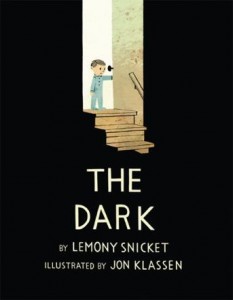 Lucky me. I got to review The Dark, a new picture book by Lemony Snickett and Jon Klassen. It was such a pleasure to read and review.
Lucky me. I got to review The Dark, a new picture book by Lemony Snickett and Jon Klassen. It was such a pleasure to read and review.
““Laszlo was afraid of the dark,” the book begins. The accompanying illustration shows Laszlo playing with his trucks in a shrinking ray of light, the sun outside the window starting to set. When the sun goes down, shadows fall throughout the house, and Laszlo fends them off with his ever-present flashlight and night light. But when the bulb in his night light burns out, Laszlo is forced to face his deepest fears.”
Read the rest here. And get this book!
May 1, 2013
Picture Book Happenings
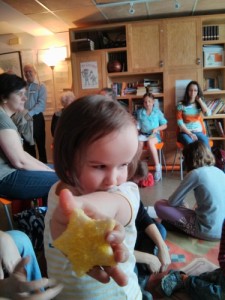 On Sunday, we had the pleasure of attending the launch for Andrew Larsen’s latest book In the Tree House (which you might recall that I adored). I do feel sorry for literary types who don’t know what they’re missing in picture book launches. The reading is never boring, they skip the Q&A (yay!) and snacks are always excellent–at this one, we got yellow star cookies, rice crispie squares and delicious lemonade. We saw lots of friends there, and had a wonderful afternoon. It was wonderful to celebrate with Andrew, who is a truly fantastic person. If you don’t know his work yet, I’d encourage you to check out any of his books. You will be enchanted.
On Sunday, we had the pleasure of attending the launch for Andrew Larsen’s latest book In the Tree House (which you might recall that I adored). I do feel sorry for literary types who don’t know what they’re missing in picture book launches. The reading is never boring, they skip the Q&A (yay!) and snacks are always excellent–at this one, we got yellow star cookies, rice crispie squares and delicious lemonade. We saw lots of friends there, and had a wonderful afternoon. It was wonderful to celebrate with Andrew, who is a truly fantastic person. If you don’t know his work yet, I’d encourage you to check out any of his books. You will be enchanted.
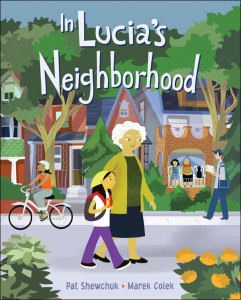 I also have a new picture book review online at Quill & Quire for In Lucia’s Neighbourhood by Pat Shewchuk and Marek Colek. While it’s not a perfect book, it’s a remarkable one, and an essential addition to the library of any urban picture book lover.
I also have a new picture book review online at Quill & Quire for In Lucia’s Neighbourhood by Pat Shewchuk and Marek Colek. While it’s not a perfect book, it’s a remarkable one, and an essential addition to the library of any urban picture book lover.
There is much to love about In Lucia’s Neighborhood, the picture book by Pat Shewchuk and Marek Colek that grew out of the duo’s celebrated animated short film Montrose Avenue. Opening with an epigraph from Jane Jacobs’ The Death and Life of Great American Cities (“The ballet of the good city sidewalk never repeats itself”), the story goes on to show how the urban theorist’s sidewalk ballet is enacted every day on one street in Toronto’s Little Portugal neighbourhood. (Read the rest here)
April 12, 2013
Stick Figure Families and the Punch List
When I was pregnant with Harriet and in my third trimester, I started creating something called a “punch list”. Let’s just say I was not the picture of serenity. And as I move toward the final month of this pregnancy, the same old rage is taking hold, and today I’ve channelled it into a post at Bunch about the inexplicable nature of stick figure family car stickers. And I really do think that “fucking Fido Dido” is the best line I’ve ever written. Dare to argue, and I’ll likely punch you.

